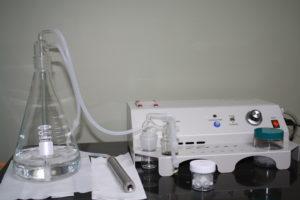By all accounts, the seminar Dr. Glaros hosted here in the office this past weekend was amazing – exciting and inspiring! The subject? Ozone therapy in dental medicine.
“Ozone?” you say. “Really?”
 For many people, the word usually conjures thoughts of pollution or the layer of atmosphere with holes in it made by industrial pollutants. Yet there’s more to it than this. For just as atmospheric ozone protects us from the sun’s ultraviolet radiation, medical ozone plays a similarly positive role in dentistry and other health specialties.
For many people, the word usually conjures thoughts of pollution or the layer of atmosphere with holes in it made by industrial pollutants. Yet there’s more to it than this. For just as atmospheric ozone protects us from the sun’s ultraviolet radiation, medical ozone plays a similarly positive role in dentistry and other health specialties.
A molecule made of three oxygen atoms, ozone was identified in 1840 and first used in the healing arts some 30 years later. It’s an unstable molecule, meaning it very much wants to lose that third atom and become O2 (the oxygen we breathe). It’s also a powerful oxidant and antimicrobial, killing bacteria, viruses, fungi and parasites.
Physicians around the world have used ozone for years to successfully treat a wide variety of conditions, from acne and allergies to hepatitis, Parkinson’s and oral infections. But there are specific dental applications, as well. Dr. Mark Breiner, author of Whole Body Dentistry, names seven:
- Bacterial infections
- Dental restorations
- Dental surgery
- TMJ
- Cavitations
- Sinus infections
- Mouth lesions
Additionally, there are some dentists who believe that thoroughly irrigating a gutted pulpal chamber with ozone disinfects enough to keep a root canal tooth from evolving into a focus of infection. However, the effects are short lived. As Dr. Marvin notes,
Studies have shown that ozone (and laser therapy in dentistry) can disinfect canals and keep them clean for about a year. But after that first year, bacteria finds a way back into the tubes. These bacteria can change from aerobic to anaerobic bacteria. Since there’s no blood flow after filling the root canal space, there’s no way for the body to fight these bacteria. They produce toxins and can release these toxins out of the root (although not through the root canal).
 Here in our office, Dr. Glaros uses ozone in many kinds of procedures but especially in NICO (cavitation), periodontal (gum) and other surgeries. Its ability to kill oral pathogens (“bad bugs” or harmful bacteria) ideally suits it to these, supporting good healing. This is especially important when it comes to treating both full-blown cavitations and less severe NICO lesions. Dr. Breiner notes that
Here in our office, Dr. Glaros uses ozone in many kinds of procedures but especially in NICO (cavitation), periodontal (gum) and other surgeries. Its ability to kill oral pathogens (“bad bugs” or harmful bacteria) ideally suits it to these, supporting good healing. This is especially important when it comes to treating both full-blown cavitations and less severe NICO lesions. Dr. Breiner notes that
Because O3 kills the bugs, enhances the immune system, promotes remineralization of bone, etc. O3 gas injected directly into the cavitational site has remarkable effects. What is really incredible is that the gas will follow the infection. For example patients having an injection into the lower right wisdom tooth area, may report feeling a funny sensation in the jaw, sometime even as far away as the left wisdom tooth area.
Ozone also plays an important role in LANAP (laser) perio surgery. While the laser does much of the disinfecting work, Dr. Glaros also irrigates the pockets with ozone about midway through the procedure to further ensure the elimination of the microbes responsible for gum disease. As in other surgeries, the ozone also promotes remineralization of the supporting bone while speeding up healing of the soft tissues that have been lased.
More, all the water we use in our treatment rooms is ozonated. For just as ozone can get rid of pathogens in the mouth, it can do so in water. In fact, many cities treat public drinking water with ozone to purify it without leaving any chemical residue or taste. The ozone merely transforms to plain old oxygen.
Not only do you get purer water but immune system and healing support, just as with directly applied ozone.
It’s another way we show our commitment to your better health through the dental care we provide. Thank you for trusting us with that calling.